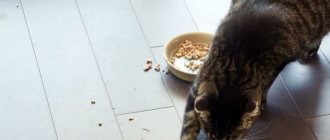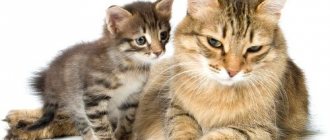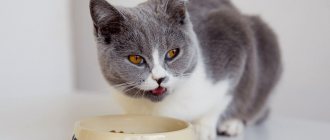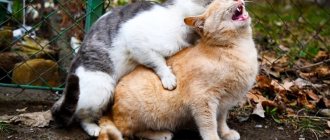Cats are very mysterious creatures; many attribute magical properties to them, which raises many questions. Some of their habits raise no less questions, for example, burying a bowl of food.
When a person began to actively move from houses on the ground to comfortable apartments, of course, he began to miss communication with nature and animals. To fill this shortage, our favorite pet, a cat, comes to the rescue. A huge number of people have cats, because they are quite unpretentious and do not require walking like a dog.
Despite all the unpretentiousness of cats, sometimes some habit of a pet can even frighten. For example, a common question among owners is: “why does a cat bury its food bowl?” When this happens, owners often get scared and think that their animal is unhealthy, but in fact the reason is much simpler. To understand this issue, you need to remember about cat instincts and habits.
Reflexes, instincts, habits of cats
The cat is originally a predator; it has retained a wide variety of instincts and unconditioned reflexes.
Instinct is the ability to act one way and not another, guided by subconscious beliefs. All instincts can be divided into three main groups:
- The first group includes instincts that ensure the functioning of the body: food instinct, sleep instinct, etc. These instincts are simply necessary for any animal; life is impossible without them.
- The second group includes instincts that help individuals communicate and interact: parental instinct, sexual instinct, etc.
- The third group includes: the instinct of play, exploration and imitation.
When doing certain things, a cat is guided by its instincts, therefore, if a cat grabs a bowl with its food, this can be explained by the presence of certain instincts and reflexes in all cats .
Avoid fasting
Most often, a pet is adopted when it is still a kitten, taken under the guardianship of good friends. However, sometimes owners take a kitten or an adult cat from strangers, not knowing for sure whether their new furry family member had sufficiently comfortable living conditions. Keep in mind that your cat may be burying her food bowl because she has previously had to go hungry. Out of habit, in order to avoid starvation, the animal begins to bury food for later.
Provide your ward with good living conditions and enough food, and then over time he will stop “stocking up.”
Ancient instincts
Unconditioned reflexes necessary for survival are passed on to all living beings “by inheritance.” Cats are among those domesticated pets in whom they manifest themselves most acutely. The desire to bury a bowl of food is one of those ancient instincts. Under natural conditions, their wild relatives try to hide leftover food from competitors in this way. This gives them the opportunity to provide themselves with one of their key needs - satisfying hunger. After all, not every hunt does a wild cat return with prey in its teeth. Having previously hidden supplies is vital for her.
The mustache and competitors living in the house can provoke the manifestation of “thrifty behavior”. The fact is that wild cats living in prides always respect subordination. At home, when the flock consists of representatives of different families, subordination in most cases is broken.
The second unconditional instinct that can explain why a cat buries a bowl of food with its paw is the desire for cleanliness. Cats are by nature predators who cannot give away their location by smell. By hiding leftover food with a sharp, attractive smell to others, a wild cat solves two problems at once: it minimizes the risk that the prey will smell it and camouflages itself from a larger predator wandering nearby.
The natural instinct to maintain cleanliness can manifest itself when an animal smells an intolerable odor. Unable to throw the “muck” into the trash, they have no choice but to bury it deeper.
Most often, cats react this way to cheap dry food that has a sharp, sour odor. A pet may try to bury a bowl of food if the food has become damp during long-term storage.
If at some point your pet begins to refuse high-quality dry food, you should not rush to replace it. The phenomenon may be temporary. After all, cats’ moods, like people’s, are very changeable. It’s just that the pet decided to temporarily change its taste preferences by arranging “fasting” days for itself.
By emptying the bowl with its paw and moving the food to another area, the animal can signal that the feeding area is uncomfortable for it. The problem can only be solved by “listening” to the messages and moving the bowl to a secluded corner where no one will disturb him during the meal.
Why do dogs eat feces?
This behavior, called coprophagia, occurs because the dog has diabetes or Cushing's syndrome, which changes its appetite. This can also happen due to nutritional deficiencies. But healthy pets often behave this way. This is explained by the fact that dogs learn this behavior during puppy life, when their mothers eat excrement to keep the “house” clean.
Travel business in a coma: coronavirus has made travel anywhere in the world impossible
Like new: the coffee table was updated and a decorative design was applied to it
Cancer and Virgo: which zodiac sign is most disliked in other countries
Acquired habits
Very often there is a mirror situation when a cat, after eating, tries not to bury, but rather to dig up supposedly hidden reserves. She scratches the floor diligently, trying to “dig up” more food as a supplement. This behavior is explained by the animal’s desire for satiety. But it is not at all necessary that the animal is hungry at the moment.
This is often the behavior of cats picked up on the street, who had to go hungry in early childhood. Their habit of storing food was formed on the basis of life experience. By hiding food “for a rainy day,” they protect themselves from the pangs of hunger deposited in their subconscious.
But even in this case, you should not indulge your pet. You still need to clear the plate after finishing the meal and feed according to the schedule. The only thing is to gradually increase the portion and see if the behavior changes.
For some cats, the desire to dig up or bury a bowl after eating may worsen in the autumn-spring period. Veterinarians explain this by vitamin deficiency, which stimulates appetite.
Important point! The feeling of constant hunger can also be caused by the presence of parasites. Therefore, you should not neglect the quarterly worming procedure.
Any habit is the result of life experience, not only positive, but also negative. So domestic cats, trained to use a litter box from childhood, clearly know that it is forbidden to set up a toilet for themselves in another place. As kittens, they probably learned the full consequences of inappropriate behavior.
The same thing happens with the food bowl. Fearing the anger of the owner if the drinking bowl installed next to the bowl overturns, who may think that the cat has peed in the wrong place, pets often try to hide the puddle by burying it or covering it with leftover food.
Competition
Quite often, a cat buries a bowl after eating because it wants to hide the leftovers from possible contenders and thus satisfy a basic need - satisfying hunger. Wild cats return from hunting from time to time without prey, so such supplies are very important.
Wild cats in nature live in packs, where everyone adheres to a certain subordination. This is not the case at home with people and other pets. The cat instinctively perceives household members as competitors, and this in turn provokes it to be “thrifty.” Oddly enough, the competition itself is not important here; for the animal, probability plays a big role.
The opposite situation occurs when the pet is not full and digs the floor after finishing the meal. In this case, he tries to instinctively “dig out” reserves. The cat is driven by an unconditional desire for satiety. Don't follow your pet's lead. Experts do not recommend leaving food in the bowl, but continuing to feed the animal on a schedule. Portions need to be increased little by little. At the same time, observe the further behavior of the cat.
Habit
In addition to instincts, a cat can be guided by its own life experience. This is how she develops some habits that are not entirely understandable to humans. If the food bowl is placed next to the water bowl, the cat may accidentally spill the water. Then she starts digging for food to clean up the puddle. Here the animal’s need for cleanliness is realized, the same one that it fulfills by instilling liquid in the tray.
Another reason why a cat may bury food without even touching it may be that the cat does not like where its bowl is located. The animal may experience discomfort and not feel safe while eating. He may be disturbed by foreign odors, unpleasant sounds, and uncomfortable temperatures. It is necessary to try to understand what exactly does not suit the pet and make adjustments: change the location of the bowl.
Saving food for later
A cat buries a bowl of food because that’s what its relatives did many years ago. This behavior is due to the desire to preserve supplies for the future. Outside the house, animals get their own food - for this they have to hunt, but not every hunt ends fruitfully. To avoid starvation, animals save food by burying it.
We recommend reading: Alopekis: a complete description of the breed, features of keeping and caring for a small Greek dog, useful photos
It is difficult to fight the instinct, and if the owners do not find other reasons for burying, they leave everything as it is.
Unpleasant smell of stale food
You can easily notice that cats love cleanliness. They are unlikely to eat food that they do not like. Therefore, if the pet sniffed the bowl and began to bury it, we can talk about the poor quality of the food or its spoilage. The cat does not have the opportunity to throw away its food, so there is nothing left to do but bury it deeper.
Particularly capricious cats bury food that has been left in the air for only 2-3 hours. It is fundamentally important for such animals that they are given only fresh food - the owners may have to feed the shrew several times a day and little by little.
Poor quality food
Cats usually smell the food first before eating. If the pet did not touch the bowl of food and even tried to bury it, this means that it did not like the food. For example, a cat may “reject” slightly spoiled or weathered food, and also refuse to eat from a dirty bowl.
By nature, all representatives of the cat family are clean people. If they don't like the smell of food, they try to get rid of it quickly. Sometimes a cat buries food because it tries to dispose of it as the contents of a dirty tray, because food should always smell appetizing and fresh.
Competition with other animals
One of the reasons why cats may bury food is due to competition with other cats or dogs that share their territory.
In this case, there are two options why the cat buries a bowl of food:
- This can happen if the cat does not live at home alone, that is, several cats or other pets live in one apartment. The instinct of competition awakens in the animal, and it buries a bowl of leftover food so that others do not encroach on its food.
- The reason may be feeding the cat outside (for example, if the owners live in a private house and prefer to place the bowl of food outside the house). In this case, the cat senses that there may be other cats nearby, and instinctively buries the leftover food so that its smell does not attract strangers.
It is worth setting the number of bowls according to the number of “heads”. In some cases, it will be necessary to delineate the place for food - if serious battles break out because of it.
Malnutrition
Here we can highlight several aspects related to why the cat does not finish eating and buries the food, leaving it for later.
Perhaps the cat has not been with you since childhood and has lived in poor conditions for some time. Cats that are accustomed to hunger will intentionally leave some of their food behind and try to bury it so that when times get tough, they have a supply that can be found and eaten. The habit is eliminated over the years if the cat lives in satiety and abundance.
If the cat really liked the food or the owner decided to pamper him with something unusual, he may try to hide some of the treats in order to return to the delicacy again later. It is more difficult to deal with such cunning - as a rule, this is part of the pet’s character.
Stress
Like many people, cats experience a lot of stress due to external factors. When an animal experiences anxiety, its appetite decreases and its health worsens. In this case, the cat may try to save food for a time when he feels better and wants to snack. Stress factors can be moving, the arrival of a new pet or small child in the house, as well as rearranging, changing the tray, filler or bowl.
If a cat buries food for no apparent reason, the owner needs to determine what this means as soon as possible so as not to miss the stressful or painful state of his pet.
Tasty food
A cat may bury a bowl of leftover food if the food offered seems very tasty to it. She leaves some food to eat later and prolong her pleasure.
Inconvenient bowl
No matter how strange it may sound, comfort is also important to animals. This also includes the dishes from which the pet eats food. If it is inconvenient for him to eat from the option offered by the owner, then most likely the food in the bowl will be buried until new utensils are purchased.
You need to choose a not very deep cup according to the size of the animal. The preferred material is metal or ceramic. Plastic emits a slight odor, and the cat will immediately refuse it. An automatic feeder can be a good purchase.
Inconvenient bowl location
If your cat buries food, you can assume that this is due to an inconvenient or incorrectly placed bowl. In this case, the cat points out to the owner what does not suit her. Perhaps the cat doesn’t like the smell of the place where it eats, the sounds made by household appliances, or everything is connected with drafts - if the bowl is close to the windows or the front door.
Try moving the plate the cat is eating from. Perhaps after the first or second rearrangement she will stop burying food.
Cat disease
Poor health can also cause a cat to bury food, as if storing it for later. Just like people, cats lose their appetite when they are sick. But due to instincts, animals tend to hide food for better times in order to finish it later - and so that the smell does not attract strangers to the bowl.
It is worth paying attention to the cat's health if she begins to malnourish and bury food, while she has signs of decreased activity and other symptoms of illness (fever, discharge from the nose or eyes, problems with the coat). If the alarming condition persists, you should take your pet to the veterinarian as soon as possible.
Hunter's Instincts
Often, pets only bury food during the fall and spring months. Felinologists explain this behavior by a lack of vitamins.
Often, a kitten or cat buries food without fully realizing the reasons for its own actions, but it listens to the following inherent instincts:
- Creation of reserves. The wild feline predator buries the leftover food for the future, so as not to die of hunger if the hunt is not successful.
- Shelter from predatory animals. The aromas of food can attract other larger animals, so the pet tries to hide the leftovers, because in nature cats lie down for the night in the same place where they eat.
- Cleaning. If the food is unfit for consumption, then predators bury it just like poop, because the stench is unpleasant to him. Predatory cats living in hot conditions are forced to bury leftovers, since the sun will quickly spoil the food. Domestic cats and kittens act this way if their owners try to feed them expired meat, fish or low-quality economy food.
- Preventing inventory theft. In the wild, cats live in a pride, and therefore the pet is afraid of competitors and scoops up its food with its paw. The situation becomes aggravated if the animal has not had access to food for a long time.
We recommend reading: Dry food with low or reduced protein content, which food contains less protein, why food with low protein content is dangerous
Increasing portions of food at the request of the animal can cause it to gain excess weight.
If a cat digs and scratches the floor near the bowl after a meal, this indicates a desire to find hidden supplies and continue the meal. However, veterinarians do not advise giving more food than required, as this can lead to obesity. The optimal dosage of dry pads is 50-80 g. It is also not recommended to disrupt the feeding schedule and time due to the fact that the pet moves the bowl and digs the ground.
Special habits of special breeds
If you have adopted a very small kitten, purebred or mixed breed, then remember that over time the pet may develop its own habits. Don't forget that the vast majority of cats love cleanliness.
If you give your tailed food in a dirty or not thoroughly washed plate, or the floor is dirty, then it is likely that he will bury the food. Yes, an animal may experience an aversion to food and its smell. Moreover, they can sense from the aroma that the product is spoiled.
Your cat's bowl should always be washed after eating.
Stress
Like many people, cats experience a lot of stress due to external factors. When an animal experiences anxiety, its appetite decreases and its health worsens. In this case, the cat may try to save food for a time when he feels better and wants to snack. Stress factors can be moving, the arrival of a new pet or small child in the house, as well as rearranging, changing the tray, filler or bowl.
If a cat buries food for no apparent reason, the owner needs to determine what this means as soon as possible so as not to miss the stressful or painful state of his pet.
Should we fight food burying?
None of the reasons why a cat buries the bowl after eating is dangerous, other than feeling unwell. Therefore, there is no need to worry about this. The pet simply expresses instincts.
If a cat’s habits do not harm it or its owners in any way, then there is no point in getting rid of them. This can be compared to the fact that part of nature is taken away from an animal. If you feel unwell, you should contact your veterinarian for advice.
If a cat's behavior causes some discomfort to the household, there are several methods that will help prevent food burying. First of all, it is recommended to carefully monitor the quality of water and food. In addition, the quality of food also affects the cat’s health. You cannot feed an animal with stagnant water for a long time, as it becomes dirty and harmful.
If there are several pets in the house, then most likely they will bury food from each other. Therefore, the best solution to the problem would be to differentiate food places. It is better when there is a separate bowl for each animal.
You need to pay enough attention to the bowl itself. It is important not to choose a bowl that is too small or too deep, as it may be uncomfortable for your pet to eat from. It is also very important to keep your cat's dishes clean. It is unlikely that any cat will agree to eat food from a dirty bowl; most likely, it will bury it and leave it until a better time.
If an animal finds itself in a stressful situation, you need to resolve it, that is, create favorable conditions for the cat: give affection or favorite treats, then the animal will be inclined to eat.
Sometimes a cat buries food because it has already eaten and is saving the rest for another time. To prevent the animal from overeating, you need to set the amount of food at a time. But it is important to find a balance, because the cat may start digging around the bowl in search of an additional portion.
In any case, if the cat’s physical condition is normal, it is not necessary to try to get rid of its habits; it may be easier for her to live with them. If the owner doesn’t like the cat’s habits, he can always try to make the pet’s life more comfortable for him, because often it is due to the lack of conditions that animals begin to behave in one way or another.
Causes of the problem
Blood in the urine
This condition is called hematuria in veterinary practice. Mostly the reason lies in the disruption of the urinary system. In addition, the possibility of developing bladder and kidney diseases cannot be ruled out. When sand appears in the organ, over time it forms stones, which begin to move along the urethra, injure the mucous membranes and cause bleeding. In addition, the following factors can provoke a condition where a pet is bleeding heavily:
- worms;
- abnormalities in the structure of the urinary system;
- pathologies of an infectious nature;
- malignant and benign neoplasms;
- injuries.
Presence of blood in stool
When a cat often goes to the toilet with a lot of blood, the following factors are to blame:
The presence of blood in the stool may be a sign that a foreign body has entered the cat's body.
- gastroenteritis;
- ulcer;
- worms;
- intestinal dysbiosis;
- bacterial diseases;
- damage to the rectum or anus;
- allergies;
- blood clotting disorder;
- ingestion of foreign objects;
- poisoning;
- neoplasms.
How to stop a cat from burying food?
Fighting instincts is futile. The cat will still reflexively bury food, guided by motives only known to it. However, owners should follow the following rules so that the cat does not have the desire to engage in “excavation”:
- Always keep the cat’s feeding area clean, avoiding the use of detergents with strong odors, and regularly wash the animal’s dishes;
- it is necessary to clearly determine the norm of food consumption for a particular pet and follow it: do not overfeed or starve;
- change the water in the drinking bowl promptly;
- monitor the quality of the food offered, and also focus on the cat’s individual taste preferences (you need to remember your least favorite food and think about how a person who is fed only food that he absolutely does not like will feel).
The feeding area should be located in such a way that nothing causes discomfort to the animal while eating: no foreign odors, no sharp sounds, no drafts.
Burying is a reflex action, which generally does not indicate any deviations. This is normal for cats. And for the caring owner there is also a lot of information about what does not suit his pet when he diligently scratches his paw on the floor near the bowl.
Inconvenient bowl location
If your cat buries food, you can assume that this is due to an inconvenient or incorrectly placed bowl. In this case, the cat points out to the owner what does not suit her. Perhaps the cat doesn’t like the smell of the place where it eats, the sounds made by household appliances, or everything is connected with drafts - if the bowl is close to the windows or the front door.
Try moving the plate the cat is eating from. Perhaps after the first or second rearrangement she will stop burying food.
Options for how to wean a cat from burying a bowl of food
There are many options for weaning an animal from burying. You should understand the possible reasons for this behavior, and then follow the basic tips:
- give food often, but in smaller portions; you need to monitor what and how much your pet eats;
- you can distract your pet with a game if the owner sees that he is starting to hide his treat;
- You should not leave the bowl when the animal has eaten. It is better to remove the cup, clean the floor and simply refresh the cup of water;
- It is important to regularly wash and scrub the bowl itself to remove any residue;
- you need to check whether the cat likes the selected brand of food;
- Do not place the eating area near the pet’s toilet.
We recommend reading: Primordial dog food: reviews, composition analysis
To wean an animal from a bad habit, you need to understand the reasons
Improve your cat's nutrition
Cats are very picky about what they eat. To wean the habit of burying food, you should adjust your diet. Basic tips:
- choose one good and high-quality brand of cat food manufacturer and stick to it in the future;
- organize meals several times a day at set times in small doses so that there is no waste left;
- reheat if necessary to increase appetite;
- you can pour chicken broth over the food to make it more attractive to your pet;
- It doesn't hurt to add a small amount of strong-smelling cheese to pique your pet's interest.
For your information! If all else fails, you should switch to wet food. Sudden changes in diet without warning can cause stomach upset.
Washing the bowl
Washing the bowl is an important part of keeping your pet's dining area clean. Cats are very picky about the order around them, especially when eating.
A dirty bowl with leftovers from your last meal can be a source of disgust. The cat recognizes such food as garbage, which it will not eat. In an attempt to get rid of garbage, the animal will bury the bowl.
Important! You should not wash the bowl with strong-smelling chemicals (household products), which can also discourage your pet from eating food. It is better to use regular laundry soap for these purposes.
It is preferable to use stainless steel utensils, since food debris can be easily removed from its walls. Plastic utensils absorb odors, and scratched surfaces can trap food residue.
Washing the bowl is the key to keeping your cat clean.
Comfortable place to eat
If your pet doesn't like the place where the food bowl is located, this fact will cause him discomfort when eating. The animal does not feel safe. The factor that is negative should be identified and eliminated. This may be: foreign or unpleasant odor, uncomfortable temperature. You should also make adjustments to the environment, for example, changing the location of the bowl.
Finally, why do pets bury their food? This is a survival instinct. Wild animals hunt and kill prey, eat food and hide the leftovers. According to the pet, food served in a bowl is no different from the fresh version. If he is not hungry enough to finish his meal, he will hide the evidence and hide it. Hiding food is a common cat behavior and is usually harmless. If the owner is interested in weaning his pet from such a habit, then it is enough to use the advice from this article.
Negative life experiences
If you haven’t had a cat since childhood, or especially a foundling, he could have had negative life experiences. Sometimes this experience still causes them to act in the “old pattern” that has become a habit. They tend to scoop up food in a secluded place just in case, and hide treats for later. A manifestation of such an experience may be “grab and run” behavior, when a noise near his bowl or the appearance of any family member in the kitchen provokes the cat to grab a piece and run to hide.
In a word, the cat still has not forgotten how to expect troubles from life. This is “treated” gradually: the first place in the process of eliminating negativity is a calm and friendly environment. Therefore, try to provide your pet with the most comfortable place to eat. Remove the bowl from a noisy kitchen if the cat cannot control the situation there. Don't frighten him with your presence.
What does instillation mean in your case?
The animal is often forced to get rid of the bowl by the smell of food that is unacceptable to it. The whole point is that:
- Most cheap dry food has a very strong and unpleasant aroma;
- the mixture quickly becomes damp or spoils if the package is left open for a long time (this often happens when it is taken by weight).
Here the same mechanism is activated that is triggered by the animal after using the toilet - waste products that emit an unpleasant odor are buried deeper so as not to reveal the presence of the cat to large predators.
When an animal lives in the house in the company of other animals, supplies are made in order to guarantee maximum food safety.
The habit itself is the result of a previous negative or positive experience.
Domestic cats become accustomed to the litter box and understand the dangers of a puddle in forbidden places. As strange as it may sound, the rules for eliminating the need directly affect the burying of the bowl. The thing is that in most cases the owners place food and drink nearby. Moreover, recently double feeding containers have gained popularity. Thus, all it takes is for the animal to accidentally push its bowl and the liquid will spill. Accordingly, a puddle appears, and the animal has unpleasant associations with it - and all he can do is eliminate the problem to the best of his ability, that is, simply try to bury it. Therefore, the pet scoops out the food with its paw and sprinkles it on the puddle.
The food smells strong, you need to bury it so that other predators don’t come!
The wild ancestors of modern domestic cats were forced to obtain their own food. They existed in conditions of fierce competition, and in order to preserve their hard-earned food, they had to hide it in safe places that their relatives and other predatory fauna could not reach.
Some of their domesticated descendants have retained this skill, and even when well fed, they continue to bury food: after eating, they scratch the floor next to the bowl with their claws.
Cats usually bury food with a distinct odor, which, in their opinion, can attract predators eager for other people's supplies.
Why does a cat touch the water in a saucer with its paw?
It has been noticed that some cats, before starting to drink from a saucer, touch the water with their paw. On many forums, when discussing the behavior of cats, participants ask questions about this “strange” behavior of cats associated with drinking water.
Let's look at one of these oddities and try to understand why this happens, and what (or whether) something needs to be done about it.
We need to hide the leftovers, in case they don’t give us any more!
It happens that for various reasons pets are deprived of food. This can happen, for example, when the owner of the animal left home for a long time without taking care to leave the pet with a sufficient amount of food, as a result of which it was forced to starve. At first, after living from hand to mouth, many four-legged inhabitants of the home bury food, fearing that the situation will repeat itself and they will again be left without food. Only when they relax and understand that their loved one is not going to deprive them of food do they stop stockpiling. Some pets still have the habit of hoarding food.
For this reason, animals that come into the house from the street also try to bury food. Why are they doing that? Street four-legged vagabonds are accustomed to shortages of food and the difficulties they had to face in obtaining it. In this regard, at first they will strive to preserve food, protecting themselves from a possible existence of hunger. Having become accustomed over time to the fact that they are fed in abundance, they will stop doing this.
The kitten sucks food.
And be sure to make sure that he poops and pees, gives him some water or dilutes his food thinner. And give him something furry, make his nest warmer. Ask another question in the section about kittens, it’s not about behavior.
I found a section about kitten diseases, but I can’t find anything about development. How many times a day should a kitten pee and poop?
The question of whether it is necessary to feed at night and at 5 am is still relevant. Thank you.
If he asks, then he must. And if he sleeps at night and does not require food, then there is no need to specially wake him up and feed him. Apparently all kittens develop differently, a long time ago they gave me a female kitten, she was only three weeks old, and she already knew how to lap from a saucer herself. And it happens that even at 6 weeks a kitten still does not understand how to eat from a bowl.
How to protect your floor from cat claws
By nature, a cat is a predator, for which its claws are a hunting tool. Of course, domestic cats almost completely forget about their instincts over time, but sometimes the animal can still remember its nature. In this case, there are several methods to protect the flooring and other objects in the house from cat claws.
Declawing
You can surgically remove your cat's claws permanently.
The operation during which an animal's claws are surgically removed is called onychectomy. It is worth noting that the procedure is effective, since you will forever protect yourself and your home from scratches.
Please also take into account the following points:
- in many countries the operation is prohibited because it is considered inhumane to animals;
- in our country, not every veterinarian will perform such a procedure;
- the price of onychectomy is quite high, so doctors willingly undertake it, whose only goal is to earn money, which casts doubt on the positive outcome of the operation;
- all manipulations are performed under general anesthesia, which negatively affects the health of the animal;
- there is a high probability of developing infections;
- the cat can only live at home - the animal will no longer survive on its own on the street;
- The phalanges are cut off along with the claws, and therefore rehabilitation for the cat will be long and painful.
Note! If you decide to surgically remove your pet's claws, you should purchase a special collar for the animal. In the first weeks after surgery, it is necessary to put it on your cat - otherwise your pet will constantly lick the stitches.
Photo of a cat after surgery wearing a special protective collar
Tendon trimming
A fairly radical measure also involves surgical intervention. In this case, a small piece is cut off from the tendon with which the cat releases its claws. Thus, the animal loses sensitivity in this place and will no longer be able to show its claws.
The operation is quite complicated, and the rehabilitation period for the cat is painful. There is a high risk of developing infections and other complications. In addition, you will have to regularly trim the animal’s claws, because the cat will no longer be able to sharpen them on its own.
Trimming claws
Only the transparent part of the claw can be trimmed.
Unlike the two methods described above, this procedure is more humane. If carried out correctly, the cat will not feel pain or discomfort. If you are going to trim an animal's claws for the first time, it is better to contact an experienced breeder or veterinarian.
A cat's claw has a blood vessel, so trimming should be done especially carefully. Look at the claw in the open - you only need to cut off the transparent part. If you hit a blood vessel, stop the bleeding with hydrogen peroxide.
Note! After trimming the claws, you should carefully monitor the animal. The cat will not be able to lead its usual life, therefore, not being able to catch on, it can easily fall from a window or from another height.
Protective caps
Silicone caps will provide reliable protection against cat claws
Recently, special caps for claws have appeared in pet stores. “Soft claws” are made of silicone and are glued using organic glue. The caps effectively protect against cat claws and are absolutely harmless to the animal.
“Soft claws” last from 4 to 8 weeks. When you first apply or replace caps, the animal's claws must be trimmed.
Accustoming a kitten to a scratching post
You can protect the floor and other objects in the house from scratches by training your cat to sharpen its claws in a certain place. To do this, you need to purchase a special scratching post at a pet store.
Do not think that it is difficult to accustom an animal to this device.
We bring to your attention a whole set of instructions, thanks to which the animal will sharpen its claws in the right place:
- place the scratching post where the animal scratches the floor or other objects, and then gradually move it to a place convenient for you;
- in order to attract the cat's attention to a new device, place your old thing on it;
- treat the scratching post with catnip extract - the substance will definitely attract the animal;
- Place the device near the place where the cat usually sleeps - after sleep, sharpening the animal’s claws is a kind of gymnastics.
You can make a scratching post with your own hands. The best option is to fasten a piece of thick furniture fabric or carpet to the board.
So, you've learned a lot about your pet's habits, and also received useful tips on how to avoid scratching the floor and other objects if your cat sharpens its claws. It is worth noting that you should not strictly punish an animal because of the manifestation of natural instincts - therefore it is better to take care that the cat’s behavior does not cause you discomfort. Interesting information is also presented in the video in this article.











